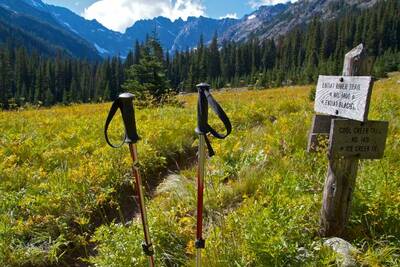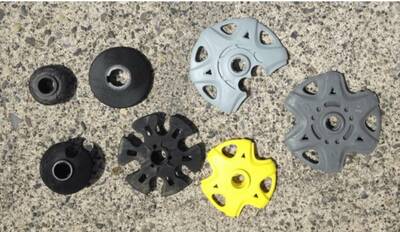Backpackers.com — In another edition of our Community Highlight feature is an article from Hartley Brody's Adventure Blog on reasons to hike with trekking poles. In the future, look for a full-length interview with Hartley, but for now read his excellent (and number friendly) discourse on why you should hike with trekking poles below. Also be sure to read Hartley's six tips for trail leaders, another article featured on our site.

He provides 10 clear reasons applicable to pretty much everyone, covering scenarios that are extremely common when you're on the trail. And, more than that, Hartley provides excellent advice on what to look for in a great trekking pole.
We add some insight and links to other articles on trekking poles — they're pretty popular in the backpacking world, despite the odd looks and seeming clunkiness of holding something while hiking.
Read the full, original post on the Adventure Blog.

10 Reasons to Hike With Trekking Poles
Here are Hartley's 10 reasons, and discourse on how to pick the right pole. All our commentary (from here on out) will be in italics.
- Help you keep your stride or pace
- Give you a boost on uphills
- Take shock off your knees on downhills
- Great for balance on slippery rocks or uneven terrain
- Extra points of contact for river crossings
- Whacking bushes, branches and spider webs out of the way
- Testing a sketchy looking rock before you put weight on it
- Fending off animals like snakes or small rodents
- Supports for pitching a tarp
- For emergency litter or splint construction
Read the expanded commentary in the original article on why each number is important.

What to Look For When Choosing Hiking Poles
Shaft Material
Most poles are made out of aluminum or carbon fiber. Carbon fiber makes the poles lighter, but also more brittle and likely to snap on rugged terrain. Aluminum is more durable, and also significantly cheaper, so that’s what I’d recommend for most people.
Shock Absorbing
Some poles come with a spring-loaded shock absorbing feature, so that the poles essentially shorten an inch or two when heavy weight is applied to them. This feature helps reduce the strain of travelling downhill, by dissipating some of your downward energy into the spring.
If you find yourself on mountainous terrain, this feature can be a lifesaver – just make sure you lock out the spring on uphills so that you can still effectively push on the poles to lift your weight.
Collapsible
Most poles have some sort of collapsing mechanism to make them shorter for travel and storage. If you’re shopping online, it’s good to read reviews from pervious owners to see what people think of the stick’s locking mechanism.
You’re looking for a combination of easy to use and also secure – you don’t want your pole to collapse when you stumble and need it to catch your weight! Also consider whether you’d be hiking in the cold and potentially need a locking mechanism you can adjust with gloves on.
Tooth at the Bottom
The real magic of the pole comes from the tiny little tooth at the bottom that grips even on slippery rocks or uneven surfaces. Carbide and steel are common for rough terrain, whereas you’d want something rubber for softer, more sensitive areas, or when hiking on paved trails or asphalt.
Trekking Baskets
Some poles come with removable trekking baskets near the bottom. These prevent the poles from sinking into snow, sand and wet mud. These are a great extra feature to have when the ground is soft and are worth leaving on, even if they’re removable.

Handle Material
The grip should be something that’s comfortable in your hand for the conditions you’re hiking in. Consider if you’d be wearing gloves in the cold, or sweating a lot in hotter areas.
Cork handles are usually found on higher end models, and proponents say they mold to your hand and help decrease vibration. Foam is more common on entry-level models and tends to be light and soft. Some poles have rubber grips which help insulate in colder weather, but also tend to rub and chafe in sweaty hands.

My Recommendation for Starter Poles
Looking for a good pair of entry-level poles that won’t break the bank?
I bought the REI Traverse Shocklight Trekking Poles a few years ago and they’ve been with me ever since. They’re aluminum sticks with foam handles, so they’re sturdy but cheap – and they also have a shock absorbing mechanism that you usually only see on higher-end poles. A great value for general purpose hikes!
They also have a women’s model with a slightly smaller grip that my girlfriend loves to use. If you don’t want the shock absorbing feature, you can save a bit of money and get the REI Traverse Trekking Poles as well.
The REI Traverse model is great for those starting out. The Black Diamond Trail Back is also a good choice for those that don't want the spring action. For those ready to drop some more cash, check out OutdoorGearLab's comprehensive review of trekking poles.
Images in order: Trekking Poles next to trail marker by Jerome Gagner via Flickr; Hartley Brody Adventure Blog Logo; Hiker walking on a glacier by Kitty Terwolbeck via Flickr; Trekking Baskets courtesy Hartley Brody; Trekking Pole Handles courtesy Hartley Brody
